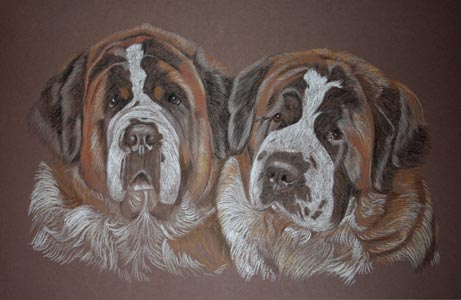Recent Pet Portraits
Search Archive
Dog Portraits
Cat Portraits
Horse Portraits
Rabbit Portraits
Sheep and Pigs
Farm Animals
Bird Portraits
People Portraits
People with Pets
Portraits of Children
Special Commissions
INFORMATION
Information
Portrait Order Form
Customer Comments
Contact
Prices
About the Artist
Gift Vouchers
Prints and Gifts
Taking Photos of Pets
Saint Bernard Portraits in Pastel by UK animal portrait artist
Guaranteed good likeness - preview your portrait online prior to payment and dispatch!

Harry and Huggy
Search the Dog Portrait Galleries for more doberman pinschers
Search for How do I commission a portrait of my St Bernard dog?
Breed Information - Saint Bernards
A powerful animal with a kindly disposition. They are intelligent and trustworthy companions and devoted to all members of the family.
Description & History
The Saint Bernard - once known as the Alpine Mastiff - is a Swiss breed and is named after the hospice in which it was bred. This hospice, which was well known as a refuge to travellers, was situated high up on a mountain pass between Switzerland and Italy.
The monks of the hospice first bred Saint Bernards in the in the latter part of the seventeenth century.
They were originally used as guard dogs and mountain guides, but their ability to sense storms and avalanches led naturally to another talent - rescue work. After storms or avalanches the Saint Bernards would use their keen sense of smell to find lost or buried travellers.
The dogs accompanying the monks knew instintively which road or track to take when searching for the victims; they would have fastened round their necks casks of liquid refreshment (not always brandy - sometimes wine or sweet tea), or food and clothing, which would be given to the rescued travellers.
Since their talent for rescue work was first discovered over 2000 people have been rescued by the breed.
The most famous of these dogs was Barry, born in 1800, who saved the lives of 40 people during a working life of 12 years. Barry died in 1814. His achievements have been commemorated in the National History Museum in Berne.
In 1905, when the Simplon Tunnel connecting Switzerland and Italy was built, the work of the Saint Bernards at the hospice gradually came to an end.
The original dogs were smaller and smooth-coated as the monks found that the rough -coated variety were impractical in the snow.
The dogs seen in the show ring today are a larger, rough-coated strain with a heavier coat. A breed which requires short but regular walks.